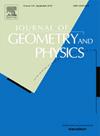The Integration Problem for principal connections
IF 1.2
3区 数学
Q1 MATHEMATICS
引用次数: 0
Abstract
In this paper we introduce the Integration Problem for principal connections. Just as a principal connection on a principal G-bundle may be used to split TQ into horizontal and vertical subbundles, a discrete connection may be used to split into horizontal and vertical submanifolds. All discrete connections induce a connection on the same principal bundle via a process known as the Lie or derivative functor. The Integration Problem consists of describing, for a principal connection , the set of all discrete connections whose associated connection is . Our first result is that for flat principal connections, the Integration Problem has a unique solution among the flat discrete connections. More broadly, we prove that the existence part of the Integration Problem always has a solution that needs not be unique. We also see that, when G is abelian, given compatible continuous and discrete curvatures the Integration Problem has a unique solution constrained by those curvatures. Last, extending the notion of discrete connection, we introduce a notion of discrete secondary Ehresmann connection associated to suitable morphisms of local Lie groupoids; then we state the Integration Problem in this context, proving that in the flat case, there is an essentially unique solution.
主体连接的集成问题
本文介绍了主体连接的积分问题。正如主g束φ:Q→M上的主连接可用于将TQ拆分为水平和垂直子束,离散连接可用于将Q×Q拆分为水平和垂直子流形。所有离散连接通过一个称为李函子或导数函子的过程在同一主束上产生一个连接。积分问题包括:对于一个主连接a,描述其关联连接为a的所有离散连接的集合。我们的第一个结果是,对于平坦主连接,积分问题在平坦离散连接中有一个唯一解。更广泛地说,我们证明了集成问题的存在部分总是有一个不需要唯一的解。我们还看到,当G是阿贝尔时,给定相容的连续和离散曲率,积分问题在这些曲率的约束下有一个唯一解。最后,扩展了离散连接的概念,引入了局部Lie群的合适态射相关的离散次Ehresmann连接的概念;然后我们在这种情况下陈述积分问题,证明在平面情况下,存在一个本质上唯一的解。
本文章由计算机程序翻译,如有差异,请以英文原文为准。
求助全文
约1分钟内获得全文
求助全文
来源期刊

Journal of Geometry and Physics
物理-物理:数学物理
CiteScore
2.90
自引率
6.70%
发文量
205
审稿时长
64 days
期刊介绍:
The Journal of Geometry and Physics is an International Journal in Mathematical Physics. The Journal stimulates the interaction between geometry and physics by publishing primary research, feature and review articles which are of common interest to practitioners in both fields.
The Journal of Geometry and Physics now also accepts Letters, allowing for rapid dissemination of outstanding results in the field of geometry and physics. Letters should not exceed a maximum of five printed journal pages (or contain a maximum of 5000 words) and should contain novel, cutting edge results that are of broad interest to the mathematical physics community. Only Letters which are expected to make a significant addition to the literature in the field will be considered.
The Journal covers the following areas of research:
Methods of:
• Algebraic and Differential Topology
• Algebraic Geometry
• Real and Complex Differential Geometry
• Riemannian Manifolds
• Symplectic Geometry
• Global Analysis, Analysis on Manifolds
• Geometric Theory of Differential Equations
• Geometric Control Theory
• Lie Groups and Lie Algebras
• Supermanifolds and Supergroups
• Discrete Geometry
• Spinors and Twistors
Applications to:
• Strings and Superstrings
• Noncommutative Topology and Geometry
• Quantum Groups
• Geometric Methods in Statistics and Probability
• Geometry Approaches to Thermodynamics
• Classical and Quantum Dynamical Systems
• Classical and Quantum Integrable Systems
• Classical and Quantum Mechanics
• Classical and Quantum Field Theory
• General Relativity
• Quantum Information
• Quantum Gravity
 求助内容:
求助内容: 应助结果提醒方式:
应助结果提醒方式:


